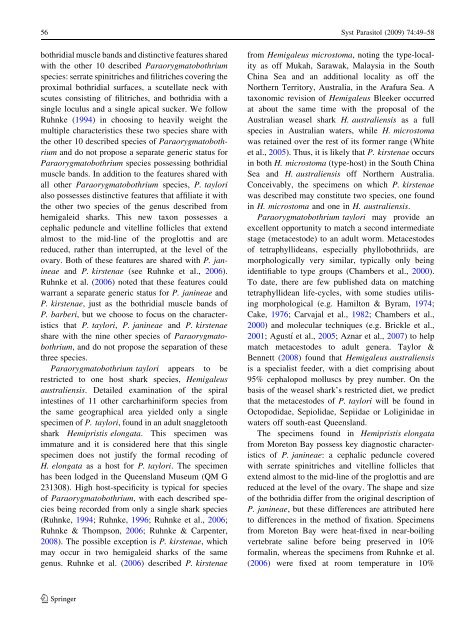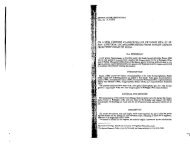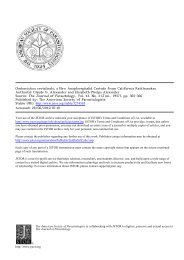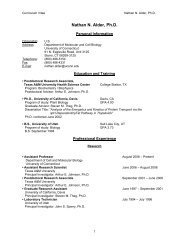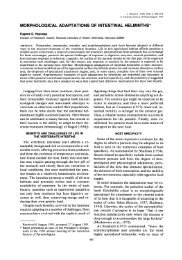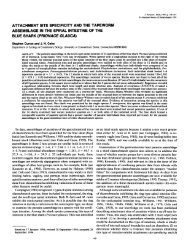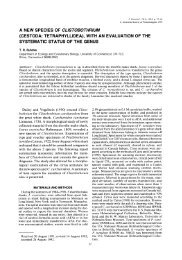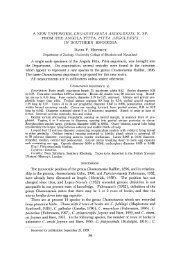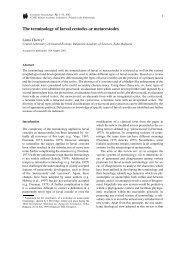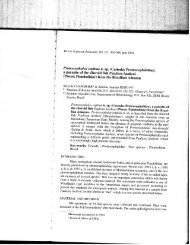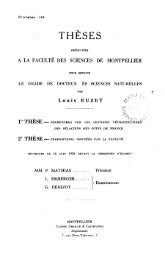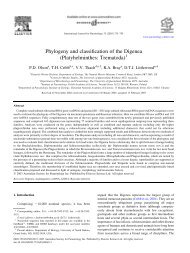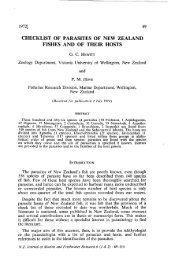Paraorygmatobothrium taylori n. sp. (Tetraphyllidea ...
Paraorygmatobothrium taylori n. sp. (Tetraphyllidea ...
Paraorygmatobothrium taylori n. sp. (Tetraphyllidea ...
You also want an ePaper? Increase the reach of your titles
YUMPU automatically turns print PDFs into web optimized ePapers that Google loves.
56 Syst Parasitol (2009) 74:49–58bothridial muscle bands and distinctive features sharedwith the other 10 described <strong>Paraorygmatobothrium</strong><strong>sp</strong>ecies: serrate <strong>sp</strong>initriches and filitriches covering theproximal bothridial surfaces, a scutellate neck withscutes consisting of filitriches, and bothridia with asingle loculus and a single apical sucker. We followRuhnke (1994) in choosing to heavily weight themultiple characteristics these two <strong>sp</strong>ecies share withthe other 10 described <strong>sp</strong>ecies of <strong>Paraorygmatobothrium</strong>and do not propose a separate generic status for<strong>Paraorygmatobothrium</strong> <strong>sp</strong>ecies possessing bothridialmuscle bands. In addition to the features shared withall other <strong>Paraorygmatobothrium</strong> <strong>sp</strong>ecies, P. <strong>taylori</strong>also possesses distinctive features that affiliate it withthe other two <strong>sp</strong>ecies of the genus described fromhemigaleid sharks. This new taxon possesses acephalic peduncle and vitelline follicles that extendalmost to the mid-line of the proglottis and arereduced, rather than interrupted, at the level of theovary. Both of these features are shared with P. janineaeand P. kirstenae (see Ruhnke et al., 2006).Ruhnke et al. (2006) noted that these features couldwarrant a separate generic status for P. janineae andP. kirstenae, just as the bothridial muscle bands ofP. barberi, but we choose to focus on the characteristicsthat P. <strong>taylori</strong>, P. janineae and P. kirstenaeshare with the nine other <strong>sp</strong>ecies of <strong>Paraorygmatobothrium</strong>,and do not propose the separation of thesethree <strong>sp</strong>ecies.<strong>Paraorygmatobothrium</strong> <strong>taylori</strong> appears to berestricted to one host shark <strong>sp</strong>ecies, Hemigaleusaustraliensis. Detailed examination of the <strong>sp</strong>iralintestines of 11 other carcharhiniform <strong>sp</strong>ecies fromthe same geographical area yielded only a single<strong>sp</strong>ecimen of P. <strong>taylori</strong>, found in an adult snaggletoothshark Hemipristis elongata. This <strong>sp</strong>ecimen wasimmature and it is considered here that this single<strong>sp</strong>ecimen does not justify the formal recoding ofH. elongata as a host for P. <strong>taylori</strong>. The <strong>sp</strong>ecimenhas been lodged in the Queensland Museum (QM G231308). High host-<strong>sp</strong>ecificity is typical for <strong>sp</strong>eciesof <strong>Paraorygmatobothrium</strong>, with each described <strong>sp</strong>eciesbeing recorded from only a single shark <strong>sp</strong>ecies(Ruhnke, 1994; Ruhnke, 1996; Ruhnke et al., 2006;Ruhnke & Thompson, 2006; Ruhnke & Carpenter,2008). The possible exception is P. kirstenae, whichmay occur in two hemigaleid sharks of the samegenus. Ruhnke et al. (2006) described P. kirstenaefrom Hemigaleus microstoma, noting the type-localityas off Mukah, Sarawak, Malaysia in the SouthChina Sea and an additional locality as off theNorthern Territory, Australia, in the Arafura Sea. Ataxonomic revision of Hemigaleus Bleeker occurredat about the same time with the proposal of theAustralian weasel shark H. australiensis as a full<strong>sp</strong>ecies in Australian waters, while H. microstomawas retained over the rest of its former range (Whiteet al., 2005). Thus, it is likely that P. kirstenae occursin both H. microstoma (type-host) in the South ChinaSea and H. australiensis off Northern Australia.Conceivably, the <strong>sp</strong>ecimens on which P. kirstenaewas described may constitute two <strong>sp</strong>ecies, one foundin H. microstoma and one in H. australiensis.<strong>Paraorygmatobothrium</strong> <strong>taylori</strong> may provide anexcellent opportunity to match a second intermediatestage (metacestode) to an adult worm. Metacestodesof tetraphyllideans, e<strong>sp</strong>ecially phyllobothriids, aremorphologically very similar, typically only beingidentifiable to type groups (Chambers et al., 2000).To date, there are few published data on matchingtetraphyllidean life-cycles, with some studies utilisingmorphological (e.g. Hamilton & Byram, 1974;Cake, 1976; Carvajal et al., 1982; Chambers et al.,2000) and molecular techniques (e.g. Brickle et al.,2001; Agustí et al., 2005; Aznar et al., 2007) to helpmatch metacestodes to adult genera. Taylor &Bennett (2008) found that Hemigaleus australiensisis a <strong>sp</strong>ecialist feeder, with a diet comprising about95% cephalopod molluscs by prey number. On thebasis of the weasel shark’s restricted diet, we predictthat the metacestodes of P. <strong>taylori</strong> will be found inOctopodidae, Sepiolidae, Sepiidae or Loliginidae inwaters off south-east Queensland.The <strong>sp</strong>ecimens found in Hemipristis elongatafrom Moreton Bay possess key diagnostic characteristicsof P. janineae: a cephalic peduncle coveredwith serrate <strong>sp</strong>initriches and vitelline follicles thatextend almost to the mid-line of the proglottis and arereduced at the level of the ovary. The shape and sizeof the bothridia differ from the original description ofP. janineae, but these differences are attributed hereto differences in the method of fixation. Specimensfrom Moreton Bay were heat-fixed in near-boilingvertebrate saline before being preserved in 10%formalin, whereas the <strong>sp</strong>ecimens from Ruhnke et al.(2006) were fixed at room temperature in 10%123


